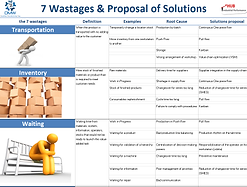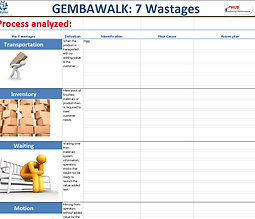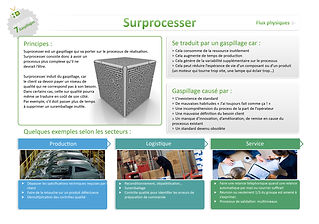IDENTIFYING WASTE
1. LEARN BY YOURSELF & CHALLENGE YOUR WAY OF DOING
WHY
The challenge of the Mudas identification and then elimination is to allow the teams to produce more without working more but simply to make sure to optimize the work and to make that each movement, gesture ... has Value added for the customer, Value that it is willing to pay.
HOW
-
Identify the steps on the mapping of Added Value then Non Added Value, as the client perceives them.
-
Among the Non Added Value identified the necessary activities from the wastages. Observe both information flow and Physical flow.
-
Optimize necessary activities and eliminate wastages.
BENEFITS
Permit to optimize the process, Increase profitability
WHAT
The cycle time of a process is divided into 3 types of tasks:
-
Value-added tasks for the customer
-
The tasks without value added but necessary for the company that is called necessary non value-added (for example the archiving of invoices)
-
The tasks that bring no value to the customer and the company = WASTAGES.
-
MUDA is the Japanese word for WASTE
There are 7 families of waste. An eighth waste is sometimes identified: Under utilizing capabilities of employees (skills).
-
Over-Production: To produce sooner, faster or greater quantities than customer demand
-
Inventory: Raw materials, work in progress or finish goods which is not having value added to it.
-
Waiting: People or part that wait for a work cycle to be completed
-
Motion: Unnecessary movement of people, parts or machines within the process.
-
Transportation: Unnecessary movement of people or parts between processes.
-
Rework: Non right first time, repetition or correction of a process.
-
Over-Processing: Processing beyond the standard required by the customer.

2. COPY & IMPROVE ASSOCIATED BEST PRACTICES
3. GO FURTHER WITH OUR COACHING OFFER
Please contact:
4. VALIDATE YOUR SKILLS
Competency = To master the fundamental of Continuous Improvement [CIMF]
5. EVALUATE YOUR ORGANIZATION
Assessment = OPEX
Chapter = O4















